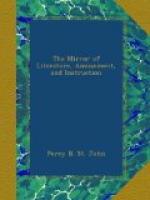By the Quene.
“Right trustie and right welbeloved, wee grete you well; and, forasmuche as by the inestimable goodnes and grace of Almighty God wee be delivered and brought in childbed of a Prince, conceived in most lawfull matrimonie between my Lord the King’s Majestie and us; doubtinge not but, for the love and affection which ye beare unto us, and to the commonwealth of this realme, the knowledge thereof should be joyous and glad tydeings unto you, we have thought good to certifie you of the same, to th’ intent you might not onely render unto God condigne thanks and praise for soe greate a benefit but alsoe continuallie praie for the longe continuance and preservacion of the same here in this life, to the honour of God, joy and pleasure of my Lord the Kinge and us, and the universall weale, quiett, and tranquillitie of this hole realm.”
“Given under our Signet, att my Lord’s Mannor of Hampton Courte, the xii daie of October."[10]
Edward was christened with great state, on the Monday following, in the chapel at Hampton Court, Archbishop Cranmer, and the Duke of Norfolk being the godfathers, and his sister, the Princess Mary, godmother.[11] “At his birth,” says Hall, “was great fires made through the whole realme, and great joye made with thankesgeuyng to Almightie God which had sent so noble a prince to succeed to the crowne of this realme."[12]
The joy, however, which the birth of a son and heir to the throne, excited in the mind of Henry was soon dispelled by the death of his queen. It was deemed necessary, both for the preservation of her life, and that of her offspring, to bring the latter into the world by means of the Caesarian operation, a mode which in the greater number of cases proves fatal to the mother. It has been maliciously, and without the least appearance of truth, asserted by Sanders,[13] one of the most bitter writers of the opposite party, that the question was put to the King by the physicians, whether the life of the Queen or the child should be saved, for it was judged impossible to preserve both? “The child’s,” he replied, “for I shall be able to find wives enough.” Whether, however, her death originated from that terrible cause, we cannot, at this distant period, pretend to affirm, but from the report to the Privy Council of the birth of Edward the Sixth, still extant, it would appear not, as it informs us she was “happily” delivered, and died afterwards of a distemper incidental to women in that condition.
The death of Jane Seymour, like the birth of her son, is involved in considerable obscurity. Most of the chroniclers who appear to have followed Herbert[14] in this particular, fix it on the fourteenth of October, two days after the birth of Edward; Hayward, on the contrary, states that “shee dyed of the incision on the fourth day following,” while Edward the Sixth, in his journal, written by himself, informs us, but without stating any precise period, that it




